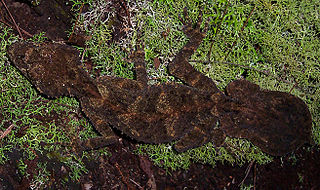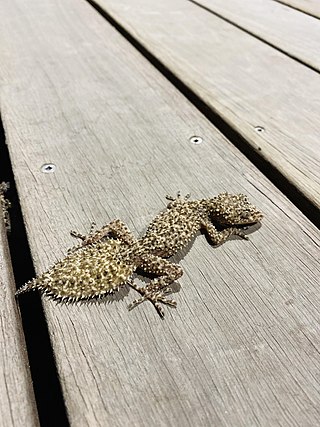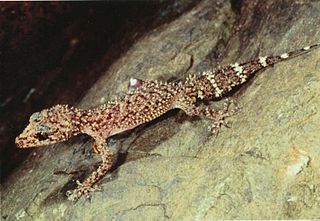
The Mauritius lowland forest day gecko, also known commonly as Guimbeau's day gecko and the orange-spotted day gecko, is a diurnal species of gecko, a lizard in the family Gekkonidae. The species is native to the western coast of Mauritius and typically inhabits large trees. The Mauritius lowland forest day gecko feeds on insects and nectar.

Uroplatus is a genus of geckos, commonly referred to as leaf-tail geckos or flat-tailed geckos, which are endemic to Madagascar and its coastal islands, such as Nosy Be. They are nocturnal, insectivorous lizards found exclusively in primary and secondary forest.

Carphodactylus is a monotypic genus of geckos in the family Carphodactylidae. The genus consists of the sole species Carphodactylus laevis, commonly known as the chameleon gecko. The species is endemic to the rainforests of northeastern Australia. It is rated as Least Concern, as it is common within its range and occurs within protected areas. It currently experiences no major threats, though long-term climate change may alter or reduce its geographic distribution under some scenarios.

Phyllurus is a small genus of Australian leaf-tailed geckos, lizards in the family Carphodactylidae. Rarely seen outside their native habitat, they are notable for their highly effective camouflage which is in part aided by the spiny tubercles that cover every body part.

Saltuarius is a genus of larger Australian geckos, known collectively as leaf-tailed geckos.

Saltuarius swaini, also known as the southern leaf-tailed gecko or Border Ranges leaf-tailed gecko is endemic to Australia where it is found in coastal mountain ranges of southeastern Queensland and northern New South Wales. It inhabits rainforests and lives inside large tree root systems and hollows of strangler figs. Its scientific name is after Malcolm Swain of the NSW National Parks & Wildlife Service.

The Sunda frogmouth is a medium sized, old world species of bird within the order Podargiformes. It is also uncommonly referred to as the long-tailed frogmouth or the horned frogmouth. The term "Sunda" is based on the geographical range of the species to regions around the Sunda islands. The genus name, Batrachostomus, is a Greek translation to ‘frogmouth’, which comes from the wide shape of the bill and slight gape. The species name cornutus is a Latin word translated to "having horns", referring to the tufts of feathers on the head.

The rose robin is a small passerine bird native to Australia. Like many brightly coloured robins of the Petroicidae, it is sexually dimorphic. The male has a distinctive pink breast. Its upperparts are dark grey with white frons, and its tail black with white tips. The underparts and shoulder are white. The female is an undistinguished grey-brown. The robin has a small black bill and eyes.

Uroplatus sikorae, commonly referred to as the mossy leaf-tailed gecko or the southern flat-tail gecko, is a species of lizard in the family Gekkonidae. The species is endemic to Madagascar. It is a CITES II protected animal due to habitat loss.

The dubious dtella, native Australian house gecko, or dubious four-clawed gecko is a species of gecko in the genus Gehyra, native to Northeastern Australia. The lizard is found in a variety of habitats, including acacia and eucalyptus woodlands, and in human-developed habitats, such as house walls in urban areas. Its urban presence makes it known as a common house gecko in Queensland. These geckos are often confused with the Asian common house gecko, which was introduced to Australia from Indonesia, but G. dubia has distinct rounded feet and quieter calls.

The broad-tailed gecko, southern leaf-tailed gecko, or Sydney leaf-tailed gecko is a common gecko of the family Carphodactylidae found in the Sydney Basin. The species uses its mottled colour to camouflage against bark or rock, and if threatened can drop its large fleshy tail as a decoy. The tail is also useful for fat storage. This species of gecko is available in captivity as a pet, they are a nocturnal ambush hunter, relying on camouflage and patience to catch prey. Primary prey items include large nocturnal invertebrates such as spiders, cockroaches and beetles.

The black-headed monitor or black-tailed monitor is a relatively small species of monitor lizards native to Australia. It is occasionally also called the mournful monitor, freckled monitor or the racehorse monitor, a name it shares with the Gould's monitor due to their exceptional speed. It is placed in the subgenus Odatria.

Oplurus cuvieri, commonly known as the collared iguana, the collared iguanid lizard, Cuvier's Madagascar skink, Cuvier's Madagascar swift, and the Madagascan collared iguana, is a species of arboreal lizard in the family Opluridae. The species is native to Madagascar and the island of Grande Comore, Comoros. There are two recognized subspecies. O. cuvieri is the largest of six species in the genus Oplurus.

Champion's leaf-tailed gecko, also known commonly as the Koumala leaf-tailed gecko, is a species of gecko, a lizard in the family Carphodactylidae. The species is endemic to Australia.

The marbled leaf-toed gecko is a gecko found in southern and southwestern South Africa and in Namibia. It is a flat, medium-sized gecko.

Diplodactylus vittatus, commonly known as the eastern stone gecko, stone gecko, and wood gecko, is a species of diplodactylid lizards that occurs in forest, shrubland and arid regions across Australia. It is widespread across the states of Queensland, Victoria and New South Wales, commonly found in dry peripheral bushlands. This gecko can be kept as a pet or seen within zoo enclosures.
Orraya is a monotypic genus of lizard in the family Carphodactylidae. The genus contains the sole species Orraya occultus, also known commonly as the McIlwraith leaf-tailed gecko or the long-necked northern leaf-tailed gecko. The species is endemic to Australia.
Saltuarius kateae, also known commonly as Kate's leaf-tailed gecko or the Mount Marsh leaf-tailed gecko is a species of gecko, a lizard in the family Carphodactylidae. The species is native to New South Wales.

Saltuarius salebrosus, also known as the rough-throated leaf-tailed gecko or Central Queensland leaf-tailed gecko, is a gecko found in Australia. It is endemic to dry areas in mid-eastern and south-central Queensland.

Diplodactylus conspicillatus, also known commonly as the variable fat-tailed gecko or the burrow-plug gecko, is a species of lizard in the family Diplodactylidae. The species is endemic to Australia, where it is found in central and arid inland areas. Widespread across the continent, the variable fat-tailed gecko is most commonly found in sandy desert habitats dominated by spinifex grasses. It has also been bred in captivity by zoos and as pets.


















